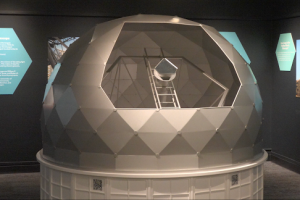Austin’s Astronomical Sights: An Exhibition Out of this World
By Gabriella Vukman
Reporting Texas

The replica of the Hobby-Eberly Telescope is part of the Texas Science and Natural History Museum’s ‘Big Eye in Dark Skies Exhibition.’ Gabriella Vukman/Reporting Texas
The Texas Science and Natural History Museum is now home to a replica of the Hobby-Eberly Telescope, the largest land-based telescope in North America.
Commemorating the McDonald Observatory and its work with the real Hobby-Eberly Telescope (HET) to map the early universe and decipher dark energy, the replica is part of an exhibition based on recently conducted research titled ‘Hobby-Eberly Telescope Dark Energy Experiment’ (HETDEX).
Monte Monreal, assistant director of Texas Science and Natural History Museum, said, “The scale model of the telescope was built for the eclipse in April 2024 and for a big event they were doing at the Long Center here in town. When that event was over after just one day, we thought,’What is another potential use or future for this beautiful piece that has been built?’”’
“We thought we have a little gallery. It will fit in there so nicely,” he said.
Up a flight of winding stairs and past various displays, the ‘Big Eye on Dark Skies’ exhibit features an array of plaques and images from the McDonald Observatory in West Texas, where the real HET is located.
Resident astronomer at the McDonald Observatory, Dr. Amy Ray said, “One of my favorite targets to observe with the HET are the supernova targets because we can actually see the star that is exploding in the galaxy.”
“I can’t wait to go to the exhibit and visit the model of the HET and see how other people react to it and how they get excited about a place that I see every day,” she said. “I love my job and I love it out here, but seeing other people get excited about it too, that would be so amazing.”
While Dr. Ray’s own research looks at chemical abundances of stars and combines it with astro-seismic data to recognise how much fuel these stars have, much of her time at the research center is spent looking after the HET.
“We missed a moth that had been smeared across one of our panels, so I am working on a machine-learning method to catch problems that may have arisen.”
As the first major experiment to search for dark energy in the early universe, the HETDEX research aimed to uncover dark energy in order to measure the accelerating expansion of the universe.
Through studying sound waves from the universe that are billions of years old and comparing them to sound waves from the present day, the HETDEX experiment was able to map some of the expansion of the universe.
With the HETDEX experiment still ongoing, the findings thus far will be presented by experts at the Texas Science and Natural History Museum on April 17.
Playing a broad role in an array of projects and research, in the next year, the research center is hoping to develop the tracking capability of the HET so that it can also start looking at comets and asteroids within our solar system.
Dr. Ray noted that the exhibition provides an accessible avenue for locals to learn about the HET and the work of the McDonald Research Center.
“We are really out in the middle of almost nowhere, so it is much more accessible, and I think that is fantastic. The more people we can reach, it’s so much better. It is close to giving you a hands-on experience that, if you can’t make it out here and come and see the telescopes in person, you can at least get that and see the work that we do in another way,” she said.
The “Big Eye in Dark Skies” exhibit is open from Tuesday to Sunday and is free for those with a University of Texas student ID.